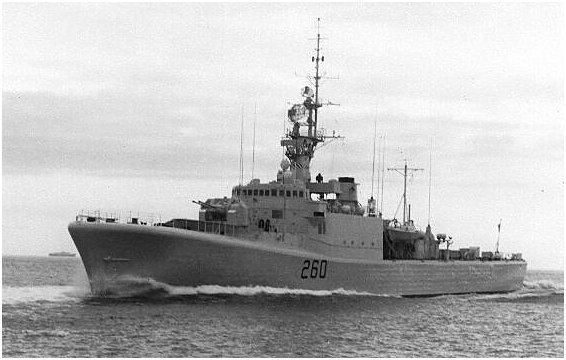Name Columbia Laid down 11 June 1952 Decommissioned 18 February 1974 Construction started 11 June 1952 Length 112 m | Commissioned 7 November 1959 Launched 1 November 1956 Draft 4.3 m | |
 | ||
HMCS Columbia was a Restigouche-class destroyer that served in the Royal Canadian Navy and later the Canadian Forces from 1959 to 1974. Columbia was the seventh and final ship in her class and is the second Canadian naval unit to carry the name HMCS Columbia. Following her service, she was kept at Esquimalt in an altered condition, no longer capable of sailing. Columbia was sold for use as an artificial reef and sunk off the coast of British Columbia in 1996.
Contents
Design and description
Based on the preceding St. Laurent-class design, the Restigouches had the same hull and propulsion, but different weaponry. Initially the St. Laurent class had been planned to be 14 ships. However the order was halved, and the following seven were redesigned to take into improvements made on the St. Laurents. As time passed, their design diverged further from that of the St. Laurents.
The ships had a displacement of 2,000 tonnes (2,000 long tons), 2,500 t (2,500 long tons) at deep load. They were designed to be 112 metres (366 ft) long with a beam of 13 metres (42 ft) and a draught of 4.01 metres (13 ft 2 in). The Restigouches had a complement of 214.
The Restigouches were by powered by two English Electric geared steam turbines, each driving a propellor shaft, using steam provided by two Babcock & Wilcox boilers. They generated 22,000 kilowatts (30,000 shp) giving the vessels a maximum speed of 28 knots (52 km/h; 32 mph).
The Restigouches were equipped with SPS-10, SPS-12, Sperry Mk 2 and SPG-48 radar along with SQS-501 and SQS-503 sonar.
Armament
The Restigouches diverged from the St. Laurents in their weaponry. The Restigouches were equipped with two twin mounts of Vickers 3-inch (76 mm)/70 calibre Mk 6 dual-purpose guns forward and maintained a single twin mount of 3-inch/50 calibre Mk 22 guns aft used in the preceding class. A Mk 69 fire control director was added to control the new guns. They were also armed with two Limbo Mk 10 mortars and two single Bofors 40 mm guns. However the 40 mm guns were dropped in the final design.
The destroyers were also equipped beginning in 1958 with Mk 43 homing torpedoes in an effort to increase the distance between the ships and their targets. The Mk 43 torpedo had a range of 4,100 metres (4,500 yd) at 15 knots (28 km/h; 17 mph). They were pitched over the side by a modified depth charge thrower.
Service history
Columbia was laid down on 11 June 1953 at Burrard Dry Dock in North Vancouver, British Columbia. Named for the a river that begins in British Columbia before flowing into the United States, Columbia was launched on 1 November 1956. She was commissioned into the Royal Canadian Navy on 7 November 1959 with the classification DDE 260.
Columbia transferred to the east coast and in 1960 and assigned to the Fifth Canadian Escort Squadron. In August, the ship recovered two crew members of a Tracker aircraft that had crashed at sea 180 nautical miles (330 km; 210 mi) south of Halifax, Nova Scotia. The aircraft had been training with Columbia and sister ship Chaudière. She was present for Nigeria's Independence ceremonies at Lagos on 1 November. In March 1961, the destroyer escort was among the ships that took part in a combined naval exercise with the United States Navy off Nova Scotia.
During the reorganization of the fleet following the unification of the Canadian Armed Forces and the creation of Maritime Command, Columbia was transferred back to the Pacific as part of the Second Canadian Escort Squadron. The ship sailed for Esquimalt in March 1967 with two other vessels being transferred; Crescent and Algonquin.
Columbia was paid off on 18 February 1974. Placed in reserve, the ship was fitted so that she could run her engines at dockside for use as a training ship. The ship was sold to the Artificial Reef Society of British Columbia and sunk as an artificial reef near Campbell River, British Columbia in June 1996.
